Article's Content
Higher ed is facing one of the most dramatic shifts in its history.
Between 2010 and 2021, US college enrollment dropped by nearly 15%. That’s 2.7 million fewer students over the last decade, and the decline is expected to continue. Fewer students are applying, and those who are look and behave nothing like the generations before them.
Colleges and universities are now competing for an increasingly smaller, more selective pool of prospects.
Demographic shifts, economic pressure, and growing skepticism about the value of a degree have all changed how students weigh their options.
At the same time, the discovery process itself has gone fully digital. While institutions continue to invest heavily in campus tours, college fairs, and glossy brochures, today’s prospective students are making critical enrollment decisions long before they’ve ever set foot on campus or even spoken with an admissions counselor.
To stay competitive, institutions need to understand two key changes:
- What matters most to today’s students and how that’s evolving
- Where the discovery process really happens and how to show up earlier
Today, we’ll break down what’s changing in the student journey and how higher ed marketers can adapt their strategy to meet the moment and secure enrollment numbers.
What Today’s Students Actually Care About (And How It’s Changed)
Over a decade ago, the National Center for Education Statistics (NCES) studied a group of high school students over their four years in secondary school to find out what shaped their college decisions. Back then, academic reputation and program availability topped the list, followed by job placement rates and cost.
That hierarchy has flipped.
Today, cost is the clear top priority, with 53% naming it as their top concern, according to BestCollege. Public in-state schools are winning out over prestigious private institutions, with public enrollment now making up 73% of all undergraduates.
Students are also weighing new priorities that barely registered in previous generations. Student outcomes like graduation rates and post-grad employment (39%) rank second. Flexibility and accessibility, especially hybrid and online learning options (36%) are close behind.
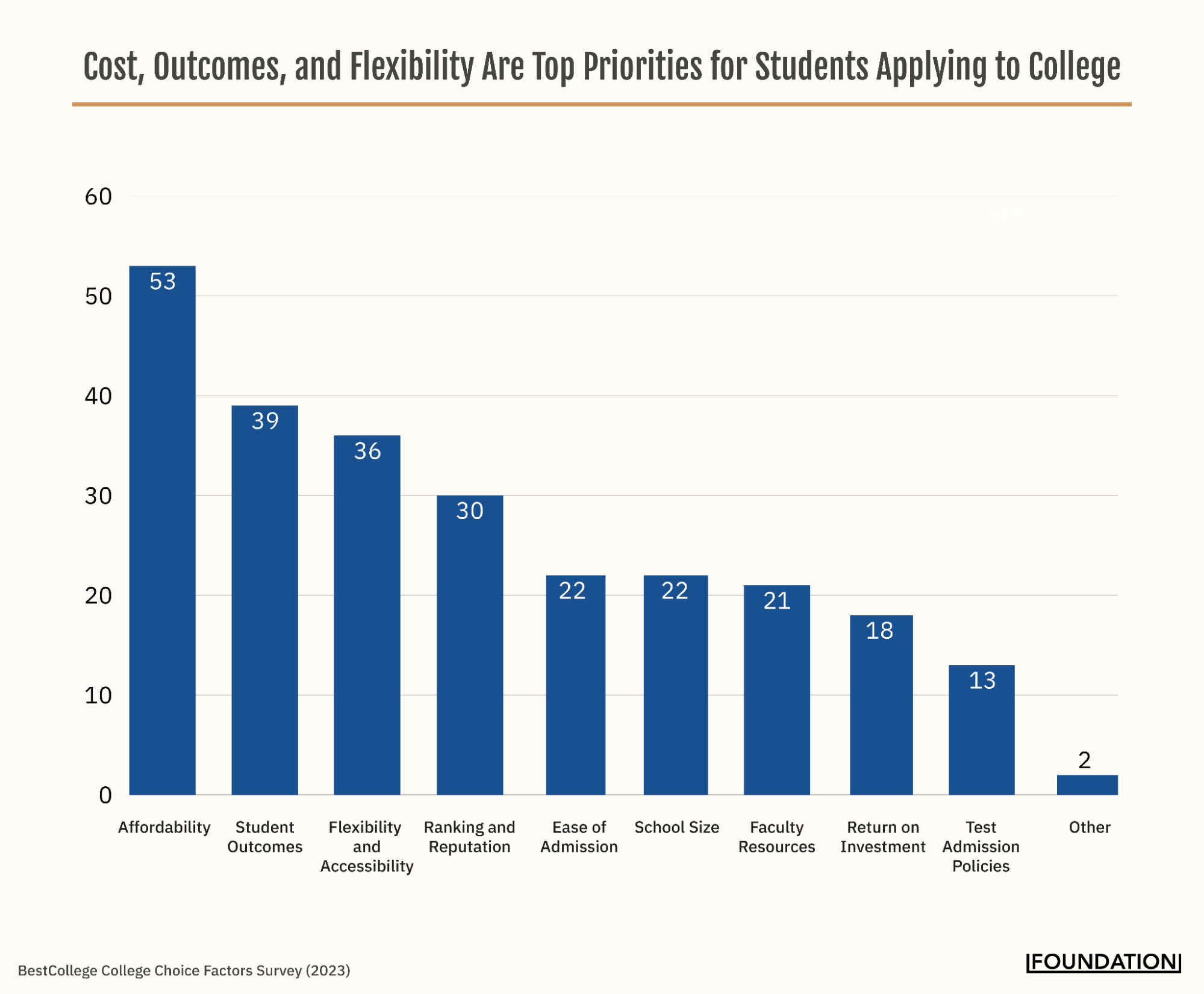
Higher ed messaging must reflect this shift.
Prestige and status are giving way to practical cost-benefit analysis. This trend is even more important considering the tens of millions of US adults with Some College, No Credential (SCNC), according to the National Student Clearinghouse Research Center. Over 2 million “recent stopouts”, students who left within the past few years, are highly likely to re-engage if schools offer affordable and flexible programs.
SCNC students, having already tested the waters, respond best to specifics like transfer credits and on-demand learning. Schools like SNHU have already worked these themes into their messaging, with measurable success.
But identifying the right message is only half the battle.
Colleges and universities must now deliver it across an increasingly fragmented digital landscape.
How the Discovery and Decision Journey Got So Fractured
The way students find and evaluate higher education options has shifted dramatically. Discovery and decision-making are now fragmented. They happen across many channels, instead of a few predictable ones.
Guidance counselor sessions, campus tours, and family discussions still matter, but students are actively seeking information elsewhere, researching program outcomes, student experiences, career prospects, and institutional culture online.
This fragmentation creates both challenges and opportunities for higher education marketers. A student might first see a program through an Instagram ad, research it via Google searches, confirm its reputation through Reddit reviews, and only then engage with official content.
All this happens before they ever set foot on campus or speak with admissions.
The institutions that succeed are those that accept this distributed journey and create discoverable, high-value content that meets students where they are, rather than waiting for them to come through traditional channels.
Where Students (and the People Who Influence Their Decisions) Go for Answers
The traditional discovery path still matters, but it’s no longer the only path. Students and their families now rely on multiple online channels, and each of them plays a role in shaping perceptions and decisions.
Ruffalo Noel Levitz’s 2025 E-Expectations Trend Report (EETR) highlights some of the most influential online experiences for prospective students.
Four channels dominate the journey:
- Organic search
- Social media
- Forums
- Artificial intelligence
Understanding where students spend their time is essential if institutions want to meet with the right content at the right moment.
Organic search
Fewer students are arriving at college websites through search engines than in previous years. According to the EETR, the percentage of students who reported using Google to find a college website fell from 58% in 2023 to 42% in 2025.
Even with this drop, organic search is still one of the top entry points during the initial stages of exploration. Search engines are where students look for broad information and build their initial lists of schools.
The demand is clear.
“Best college” keyword variants like “best colleges in the US”, “best online colleges”, or “best colleges in [State]” collectively earn 540 thousand monthly searches across 39,000+ variations.
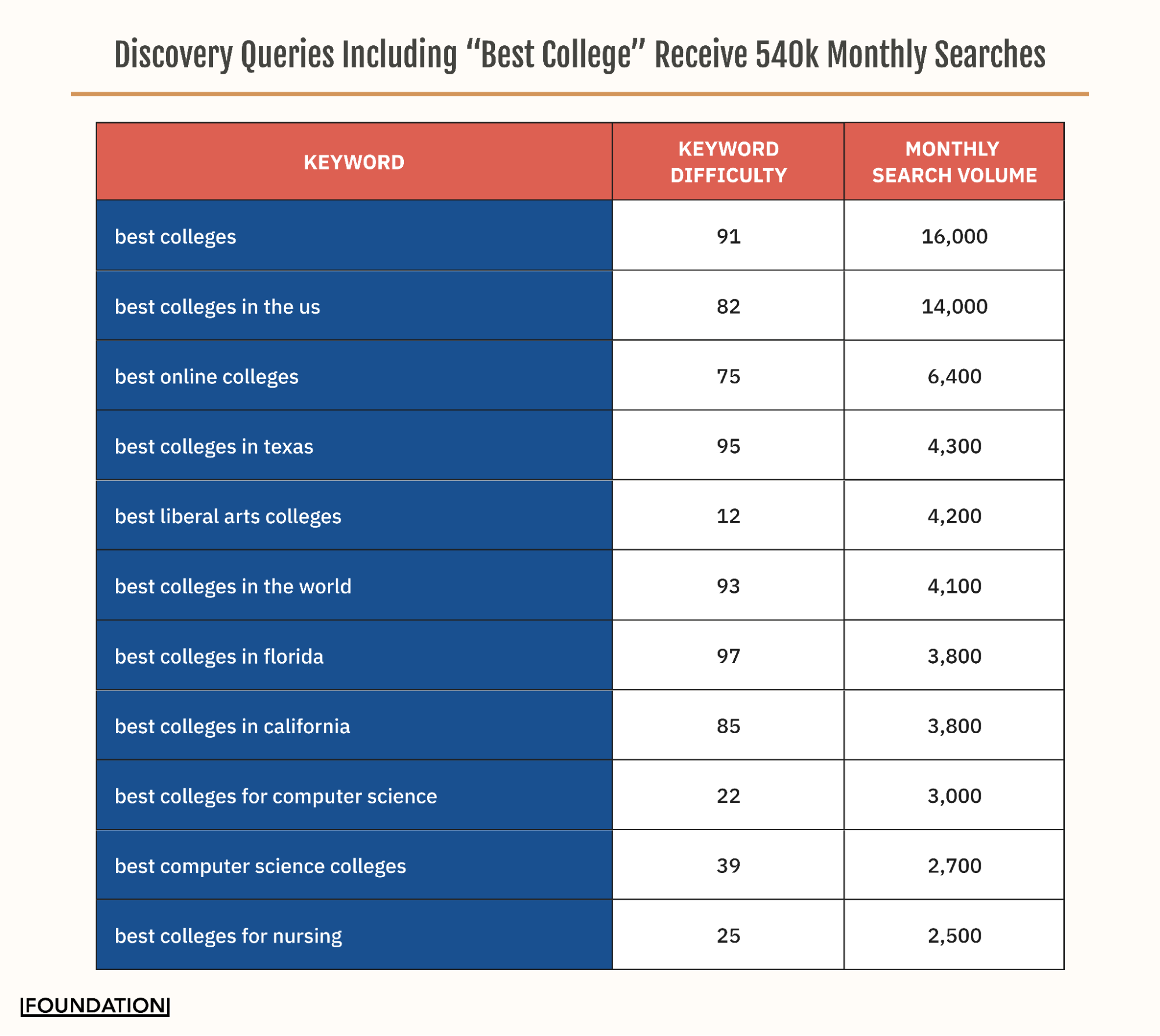
These “best of” searches reveal what families want: quick, reliable lists to narrow down options.
Competitive data from Ahrefs shows that:
- Regional or state-focused keywords are highly competitive.
- Field- and program-specific keywords (liberal arts, nursing, computer science) are less competitive.
- “Best online colleges” draws ~6,500 searches monthly with a crowded SERP.
Right now, field- and program-specific keywords are ripe for the picking.
Search data also shows that students often start their research with very broad questions. For example, “What college should I go to?” gets around 4,400 monthly searches. This signals that many are still in the early stages of discovery when they turn to search engines.
The EETR also found that 41% of high school students search for specific majors and academic programs when looking for schools. This means program-driven content is a smart way to capture attention.
Search plays a role in decision-making as well as discovery. Students use it to compare schools, verify outcomes, and even question whether higher education is worth the investment. Not everyone exploring the idea of college or university is sold on it.
Each month, nearly 10,000 people search “is college worth it?” These searches pull up news articles and heated discussions about the value of a degree.
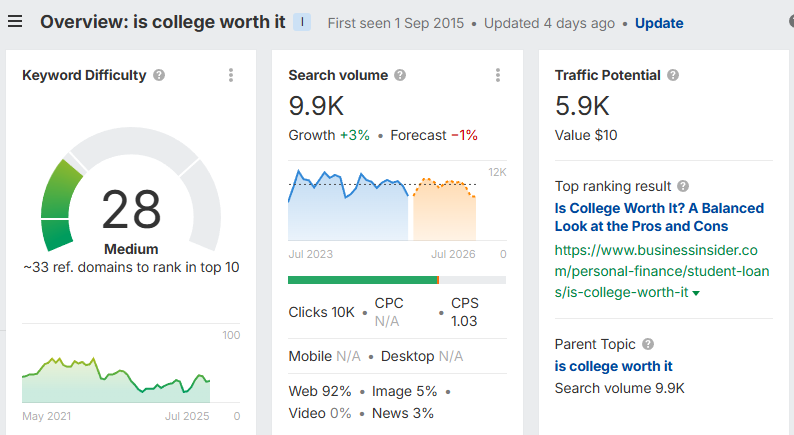
This growing skepticism is why schools with employment-focused content strategies, like WGU’s career guides, are seeing strong results.
The takeaway:
To win in organic search, colleges and universities must go beyond “best college” lists. Content in should tackle real questions about tuition costs, workforce preparedness, and flexible learning, showing why the institution is a strong return on investment.
Social Media
According to the 2025 EETR, 56% of high schoolers use social media early in their college search, often before visiting a school’s website, let alone campus.
Social platforms have become the go-to place for students to get the “vibe” of life on campus.
Instagram, YouTube, and TikTok are the top channels where high school students encounter college information.
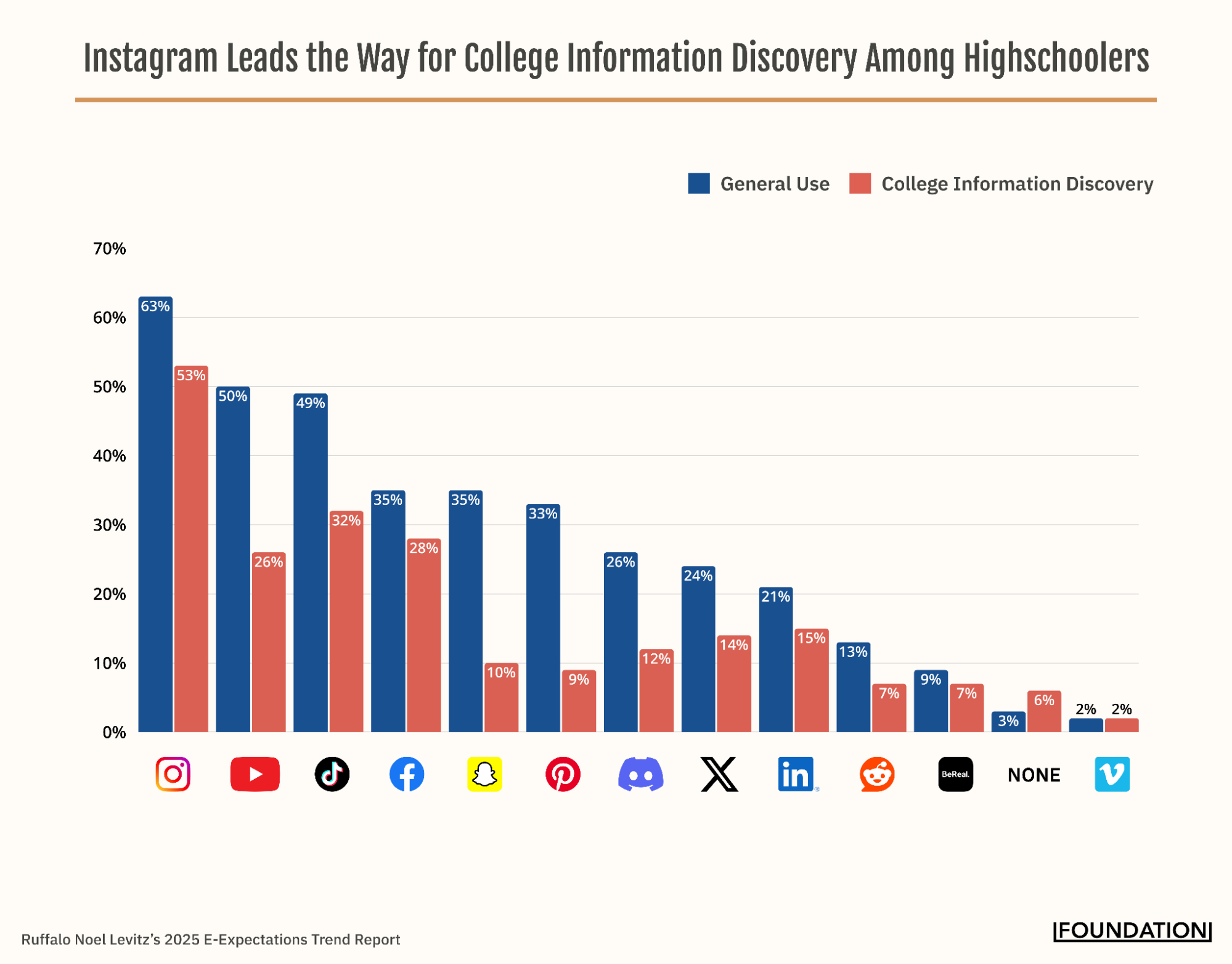
These platforms allow students to see authentic, unfiltered snapshots of campus culture by simply typing in a school’s name or browsing popular terms like “how to choose a college” or #campuslife. But social media’s real power lies in influencing students who are already considering a specific school. Yet the EETR data reveals a gap between student activity and institutional presence:
- 63% of students use Instagram, but only 53% encounter college content there.
- Half of all students are on TikTok and YouTube, yet just 32% and 26%, respectively, see college-related content.
Closing that gap means meeting students where they are, with content designed for the platforms they love. Short-form videos, such as a day-in-life clips, quick campus tours, or student Q&A sessions, are especially effective.
Instagram remains the top hub for authentic student life content, with 37% of students saying it’s their main reason for following college accounts. But TikTok and YouTube also work well for this type of storytelling.
Marquette University’s Instagram account is a great example. Their feed combines lifestyle moments, like photos of families on move-in day, with practical videos, such as guides to free student transit options.
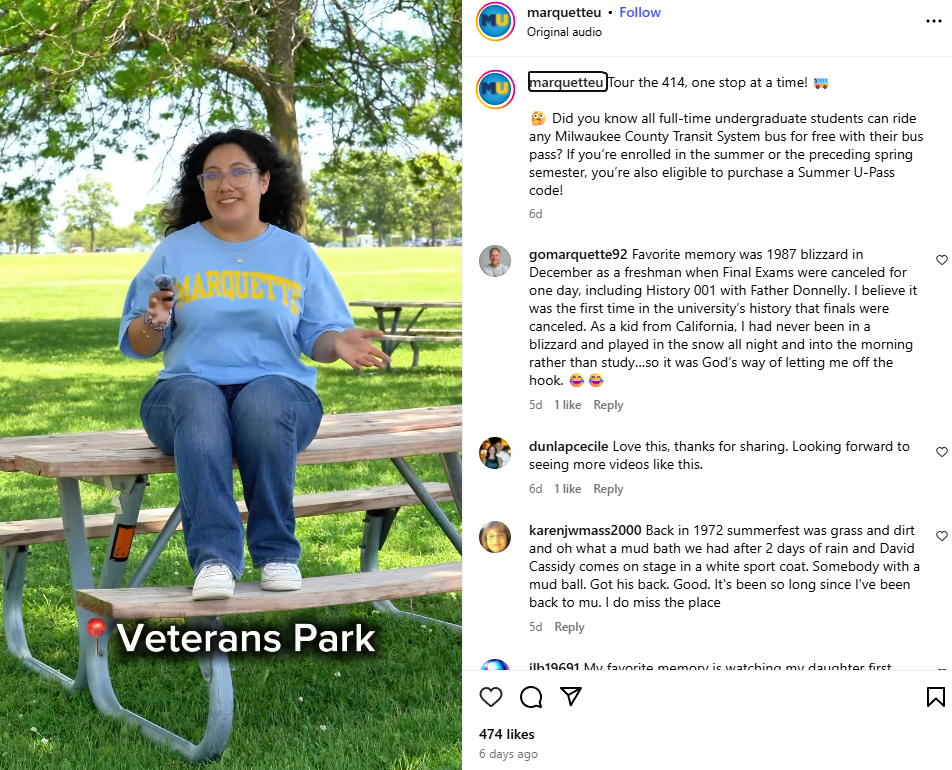
This type of content helps students imagine life on campus while also appealing to parents, who influence the decision process.
Still, lifestyle is only part of the equation. Students remain focused on cost, outcomes, and flexibility. A strong social strategy should showcase campus culture alongside financial and career benefits to help prospective students connect both emotionally and practically with the institution.
Artificial Intelligence
AI is quickly becoming one of the most disruptive tools students use to plan their academic future. Just as the last generation grew up with smartphones and social media, the next wave of college applicants is growing up with artificial intelligence.
Pew Research reports that the number of US teens (13-17) who use ChatGPT for schoolwork has doubled over the past two years, jumping from 13% to 26%. According to SparkToro, ChatGPT is the sixth most popular search/AI tool among young people exploring which college to go to, and this audience is 95% more likely to use ChatGPT than the average US population.
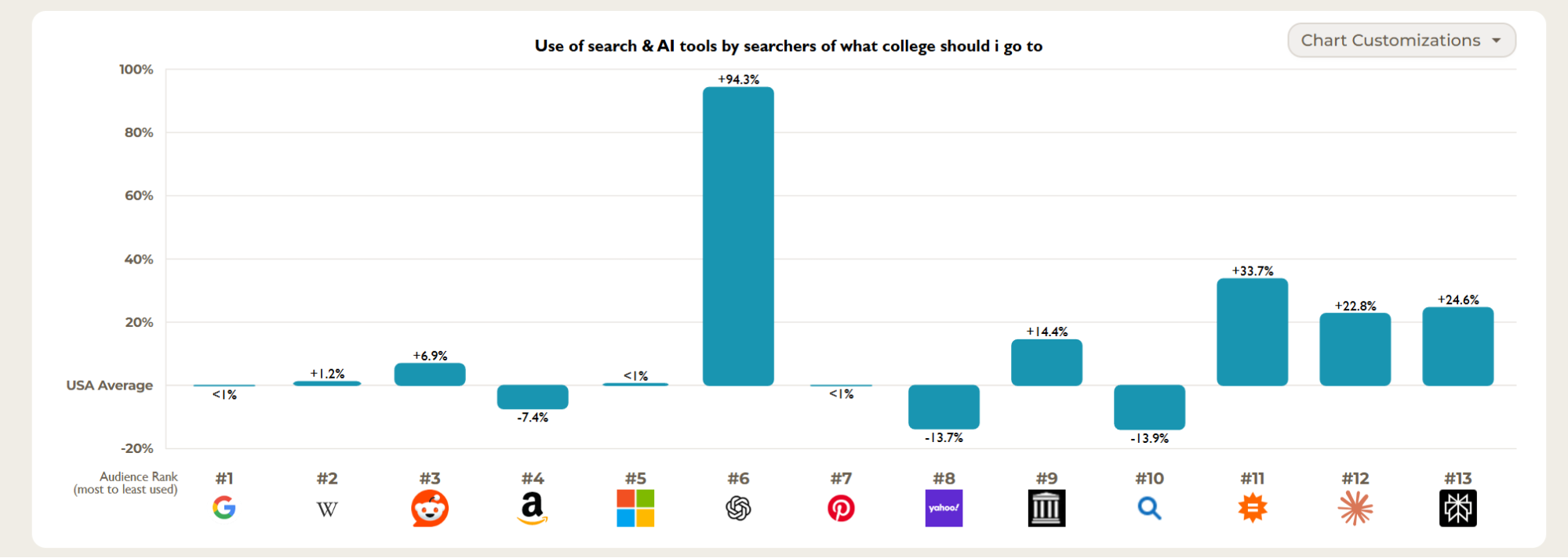
The appeal is clear.
Choosing a college involves personal, complex decisions. While Google surfaces relevant articles or forums that provide deep context, tools like ChatGPT and Perplexity offer hyper-specific, conversational answers that feel more tailored to the student’s situation.
AI’s role is growing for another reason: AI outputs often draw from top-performing organic content. If your institution ranks high in search results for a key topic, there’s a good chance that ChatGPT or Perplexity will reference it. But this overlap isn’t perfect. To stay visible, higher ed marketers need to consider generative engine optimization (GEO) alongside traditional SEO.
As students adopt AI tools, and as Google introduces AI Overviews and AI Mode, optimizing content for AI citation is becoming essential. We’re still in the early days of GEO, but creating landing pages and blog content that are friendly to humans, search engines, and AI crawlers is guaranteed to increase in importance.
Forums (Reddit and Quora)
Only 13% of the EETR respondents report using Reddit, but it’s far too valuable to ignore.
Audience research from Sparktoro shows that Reddit is one of the top three social platforms used by students deciding which college to go to. Another leading forum platform, Quora, comes in sixth. Both are likely used more by this audience than the average US population.
These platforms offer something that Instagram and TikTok can’t: in-depth, unfiltered discussions. People go to Reddit and Quora for honest advice about major life decisions.
Say, like, where to spend six figures on a degree.
The value is reinforced by the fact that Quora discussions and Reddit thread answers now rank prominently in Google search results.
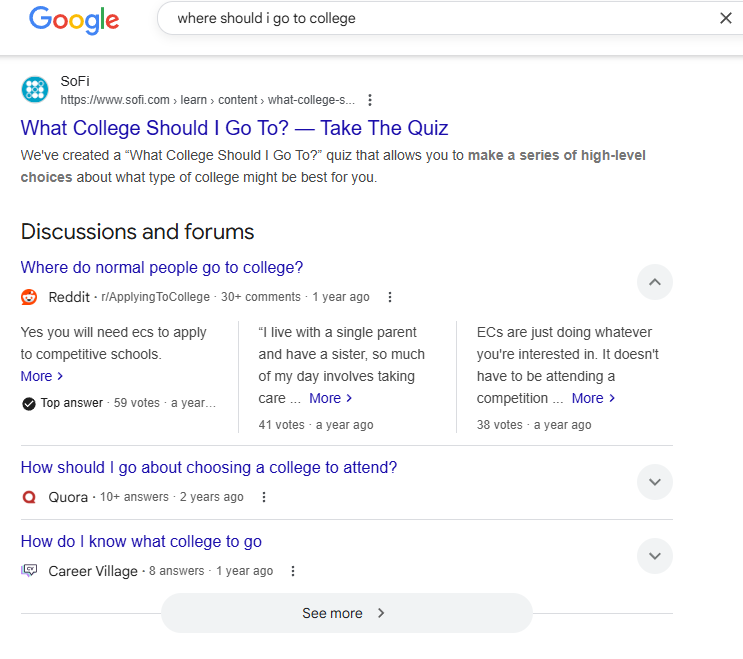
Anonymity fuels authenticity.
On Reddit, students can share candid experiences without fear of judgment. This matters at a time when concerns about cost and ROI are at an all-time high. The r/ApplyingToCollege subreddit, for example, has 1.2 million members actively discussing campus culture, admissions strategies, and financial realities.
Take the post below. A Redditor and first-generation student asks for advice on how to pick a college. Cost comes up as a key factor for them.
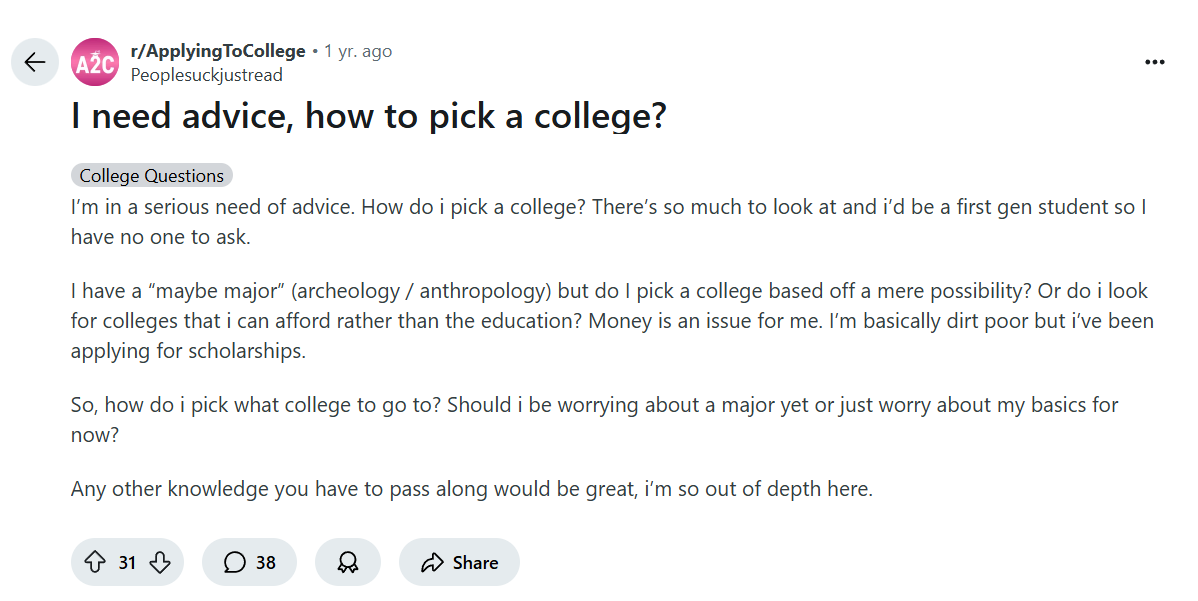
Posts like this show how financial considerations dominate today’s decision-making, but also highlight how program availability and outcomes remain critical.
Current students, including those who are at risk of leaving, also turn to Reddit for guidance.
In the thread below, an accounting student debated whether continuing to pay for school was worth it versus switching majors or pursuing an alternative path.
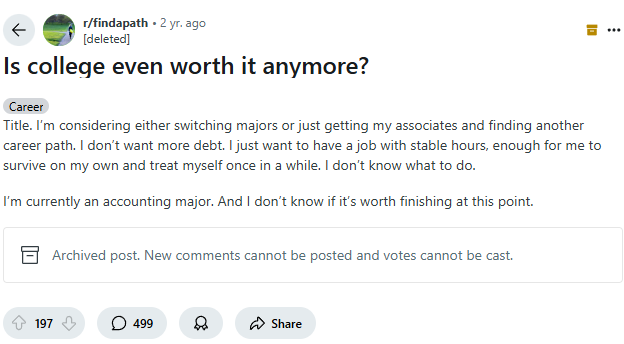
Nearly 500 comments from recent graduates to seasoned professionals weighed in, with one clear message:
Choose a degree that leads directly to employment.
The popularity of this Reddit thread pushed it into Google results for “is college even worth it.” It appears for searches within the Reddit platform, but it also brings in over a thousand visits through organic search.
Reddit marketing isn’t typically a top priority for higher ed institutions, but it should be on their radars. These forums offer a wealth of insights and opportunities:
- Gathering qualitative feedback from students and alumni about campus life and program quality.
- Identifying emerging topics and authentic messaging styles for websites, social content, and campaigns.
- Connecting prospective and current students to resources and support they might miss elsewhere.
The best part is, many major colleges and universities already have large communities. For example, both Purdue and the University of Illinois Urbana-Champaign have large unofficial subreddits with 83,000 and 103,000 members, respectively.
Even if these forums are unofficial, they are powerful spaces for building community and shaping perception.
How to Reach Students Where They’re Already Looking
The days of relying on reputation and waiting for students to come to you through traditional channels are over.
Successful institutions now meet students where they already spend their time researching and making decisions.
To understand how these channels work together, consider a typical student moving through the first three stages of the enrollment funnel:
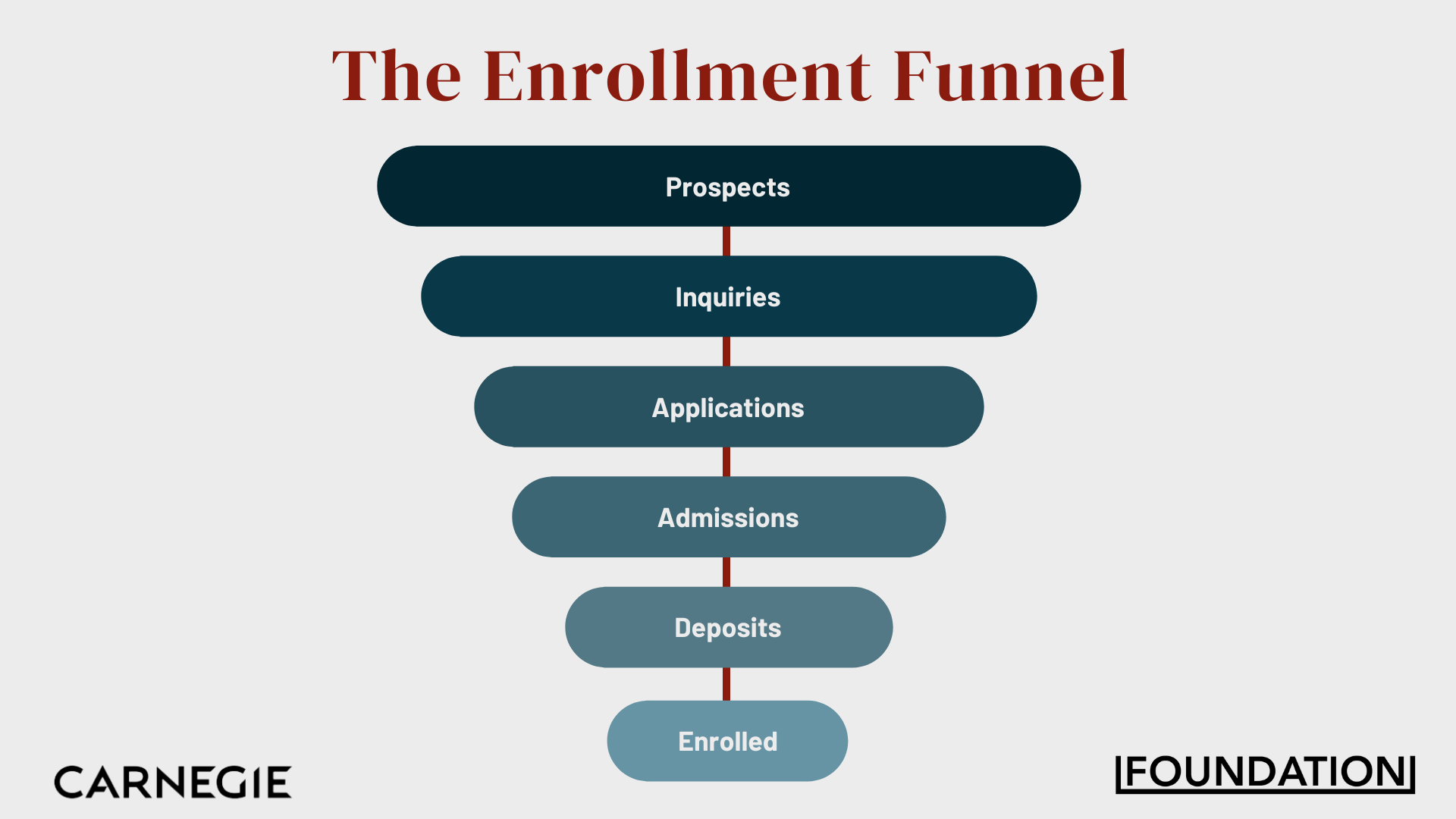
- Prospect: A high school junior discovers your institution through a TikTok campus tour or finds your content on Google for “best colleges for computer science.”
- Inquiry: That same student checks Reddit for authentic student experiences, asking questions like “What’s it really like to study engineering at [University Name]?”. They might also browse program-specific discussions on Quora or ask ChatGPT to compare your programs against competitors.
- Application: As they get closer to applying, they return to your website for details on requirements, deadlines, and financial aid. They follow your Instagram account for regular updates and use your content to confirm their interest.
The most successful institutions map their content strategy across the entire enrollment journey. They create SEO-optimized blog content for high-intent searches, share authentic social media stories that showcase campus life, engage meaningfully in online forums, and optimize content for AI discoverability.
The Future of Higher Education Marketing is Already Here
The higher education discovery process has fundamentally changed, and institutions need to adapt. Quickly.
Students now prioritize cost and outcomes over prestige, and do their research across fragmented digital channels long before traditional recruitment touchpoints ever happen.
Successful institutions will be those that align their messaging with student priorities and emphasize affordability, job placement, and flexibility. They’ll also make sure their message is discoverable through organic search, social media, forums, and AI platforms.
The opportunity is massive. Most competitors still rely on outdated approaches, leaving space for forward-thinking institutions to connect with students early in the research phase.
Ready to transform your institution’s recruitment strategy and meet prospective students where they are? Now is the time to invest in digital marketing for higher ed.







